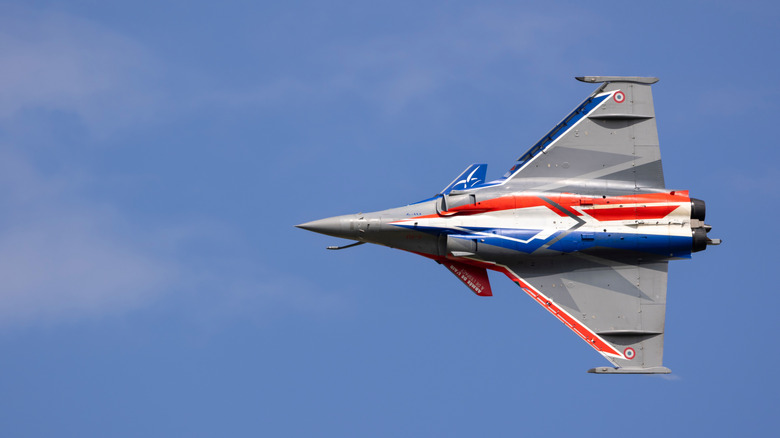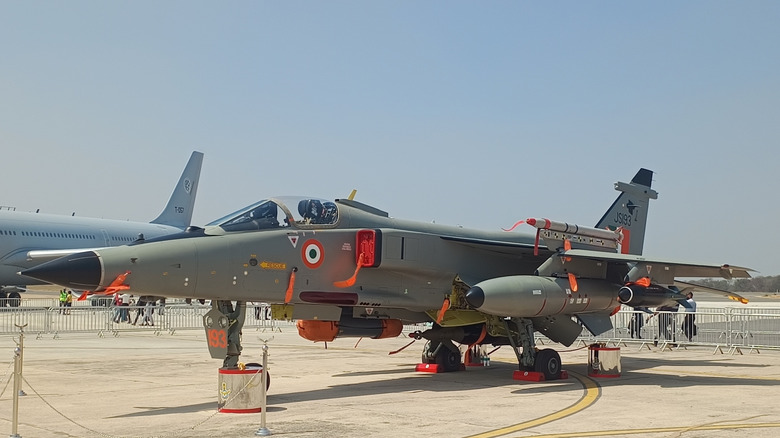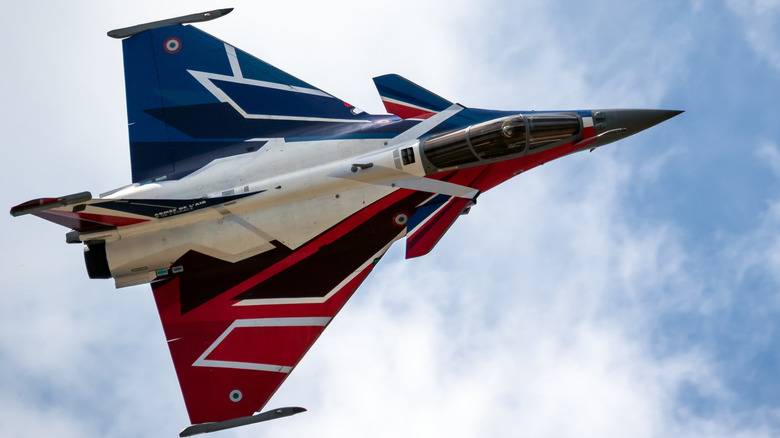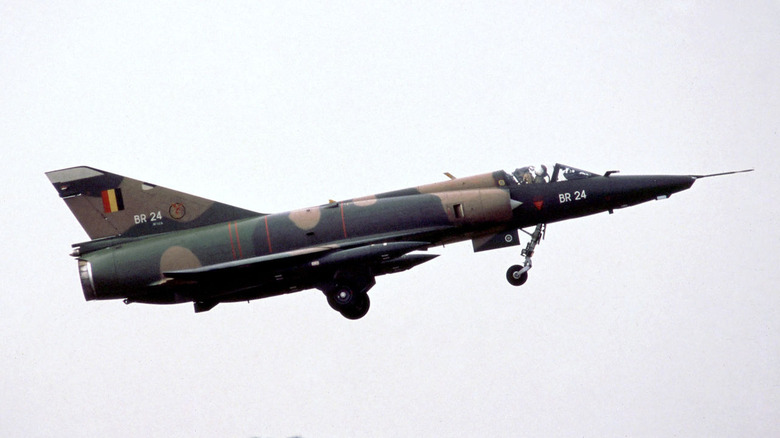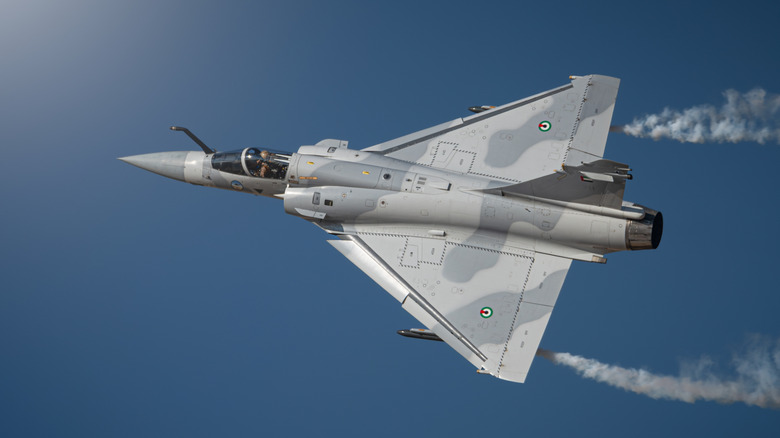5 Of The Newest French-Made Jet Fighters, Ranked By Top Speed
The United States owns the two largest air forces in the world — the U.S. Air Force and the U.S. Navy. The F-22 and F-35 fighters, developed in collaboration between the military and American defense contractors, represent the most advanced air superiority platforms available. Yet while those fifth-generation fighters capture much of the media glory, the workhorse of the world's air forces has been the fourth-generation fighter aircraft. In this category, the U.S. has competition.
European countries and blocs have maintained air forces in support of self-defense and Cold War strategy since the end of the Second World War. France is one of the few nations on the planet that can produce and operate its own jet fighters. It is also the only other nation in the world that operates a nuclear aircraft carrier, even if the Charles de Gaulle isn't exactly getting younger. France cares about its military capabilities, and fielding an air force is one of them.
In the wake of World War II, France began exploring jet technology alongside the Soviet Union, Great Britain, and the United States. The Dassault MD 450 Ouragan, the first French jet fighter to enter production, performed its maiden flight in 1949 and went operational in 1955. In the decades since the French have established a fine tradition in the military and civil aviation sectors. With much discussion in the news about the global role of the F-35, we take a visit to our French friends to examine some of the newest jet fighters sent aloft from French fields, ranked by speed.
1. Alpha Jet Mach .08/~600 mph
Known for its World War II bomber aircraft and experimental jet-powered VTOL aircraft of the Cold War, German aircraft manufacturer Dornier teamed up with Dassault to develop the Alpha Jet. The aviation firms began design work on the Alpha Jet in 1968. Each nation would operate the resulting aircraft. Germany sought to use it in a light attack role, while France preferred it as a trainer.
The Alpha Jet A, with a wingspan of 30 feet and a length of 43 feet, is a marvel of engineering. Weighing 11,000 pounds fully loaded, its bubble canopy provides exceptional forward visibility for two crew, a feature that is a boon for training and attack pilots.
As a light attack and trainer aircraft, the Alpha Jet was not a purpose-built air superiority jet. It would weigh less and achieve much lower speeds than a fighter plane. A pair of SNECMA/Turbomeca Larzac 04-C6 turbofan engines, with a combined thrust of 6,000 pounds, power the Alpha Jet to a service ceiling of 50,000 feet and a maximum range of over 1,700 miles, with a maximum top speed of just over 600 mph.
The Alpha Jet's journey began with the inaugural flight of the prototype in 1973, marking the start of a robust and successful program. Over 500 Alpha Jets were built by Germany and France, with more than half of them operating in 10 air forces outside the builder nations. Despite being largely outdated and outclassed by modern standards, the Alpha Jet continues to serve in military operations, a testament to its enduring utilitarianism.
2. SEPECAT Jaguar Mach 1.3/~990 mph
French aviation company Dassault acquired a smaller firm named Breguet by purchasing a 66% stake in June 1967. Among the projects in development by Breguet for the French government was a partnership with the British Aircraft Corporation to develop a supersonic jet trainer. Beginning in 1965, the design process changed in response to shifting requirements, as the corporate merger and the needs of the involved governments impacted the program.
The prototype Jaguar took to the sky in 1968. By then, its role had been tweaked to that of a strike fighter. It was capable of low-altitude nuclear strike and ground attack support missions in addition to boasting some respectable stats. The Jaguar had a wingspan of 29 feet and a length of 55 feet, making it a long but agile-looking aircraft. Powered by a pair of Rolls-Royce/Turbomeca Adour turbofans, each making over 8,000 pounds of thrust, it could achieve a maximum altitude of over 45,000 feet and a top possible speed of around 990 mph, or Mach 1.3.
The Jaguar served in multiple militaries, including entering the French Air Force in 1973 and the Royal Air Force in 1974. It eventually also served in India, Oman, Ecuador, and Nigeria. Both the French and British deployed Jaguars during the Persian Gulf War of 1990-1991. Although it has been retired from service by both of its home countries, the Indian Air Force continued to operate Jaguars at least as late as 2024.
3. Dassault Rafale Mach 1.8/~1,400 mph
Amidst the evolving technological landscape of the Cold War era, the need for versatile multirole fighters became paramount. The French government sought an air superiority fighter that could engage ground targets and operate from an aircraft carrier.
The inception of the Future European Fighter Aircraft program in 1983 marked a significant milestone in the aviation industry. It brought together a multi-national design team and French aircraft manufacturer Dassault, each member contributing to the development of a fighter that would meet their nation's specific needs.
The Dassault Rafale, which emerged from the Future European Fighter Aircraft program, would ultimately be developed into three variants. The C and B were land-operated with a single and double seat, respectively. The two-seater M could launch from an aircraft carrier. It achieved full-service duty by 2006, and it wouldn't be long before the Rafale got its combat initiation. On March 28, 2007, a Rafale deployed a GBU-12 bomb on enemy ground forces in Afghanistan.
Even sleek and modern fighters need updates, and Dassault is working on an updated Super Rafale. Today, the Rafale remains a core of French military capability. The home-brewed jets number over 230 in the French forces, while the government also allows their sale abroad. India is one nation that not only uses the Rafale but also produces it under license! India currently has about 30 airframes. The most up-to-date editions of the Rafale are 4.5-generation fighters that bridge the gap between the early fourth generation and the current fifth generation. It is a supersonic aircraft capable of reaching Mach 1.8, or approximately 1,400 mph, in part due to its delta-wing-style fuselage design, which also contributes to its positive handling and range characteristics.
4. Mirage 5 Mach 1.9/~1,460 mph
The Mirage jet fighter has a rich history in France and among its allies and trading partners. First flown as the Mirage III in 1956, the airframe's stellar performance in the Six-Day War of 1967 proved it a combat-worthy aircraft. The Mirage III defended national sovereignty as part of the arsenals of Brazil, Lebanon, South Africa, Pakistan, Spain, Switzerland, and others. The Mirage III spawned an entire family of French fighter craft, including the Mirage F-1 and Mirage 5.
The updated, simplified, and ready-for-export Mirage 5 first slipped the surly bonds of Earth in 1967. With its new capability as a ground attack plane, in addition to its air-to-air mission, it was a relatively simple fighter jet that offered 32% better fuel capacity and cost less than the Mirage III. It could also carry a variety of armaments.
During testing, the Mirage 5 reached speeds of Mach 1.52 and Mach 1.8. According to Dassault, the Mirage 5 could achieve a maximum speed of Mach 1.9, or approximately 1,460 mph. It is safe to assume that a top-condition Mirage 5, in ideal conditions, can easily break the sound barrier and still have plenty of power left. The Mirage 5 might not quite be able to reach Mach 2.0, but it could fly high, up to nearly 60,000 feet. Though its cruising speed was likely far lower than its top speed, it remains a respected and successful airframe.
5. Mirage 2000 Mach 2+/~1,500 mph
Development for Dassault's Mirage 2000 began in the 1970s, making it roughly contemporaneous with America's F-16 Fighting Falcon. While that may be a long time ago in the auto industry, the development and production of sophisticated military aircraft can take decades. Nations that develop these jets also go to great expense to keep them operational and competitive for as long as possible with updates.
The Mirage 2000, despite the name, took flight well before the millennium in March of 1978. With a SNECMA M53 turbofan engine generating between 18,000 and 20,000 pounds of thrust, it was a powerful aircraft. The Mirage 2000 entered service with the French fleet in April 1983, with updated models following soon after. France eventually counted nuclear strike, ground attack, and multi-seat training-capable Mirages operational.
As a combat-capable aircraft, the Mirage 2000 was a great success. It is 47 feet long with a wingspan of 30 feet and could achieve a maximum climbing speed of 60,000 feet per minute. Detailed performance information about active military aircraft can be challenging to pinpoint, but Dassault claims the Mirage 2000 can achieve a maximum Mach number of more than 2, which is roughly 1,500 mph or higher.
Dassault continued to develop the Mirage 2000, and eventually, the French Air Force had over 300 delivered, with 250 additional airframes sold to foreign forces. Between 1987 and 2007, over 600 Mirage 2000s were introduced into military service. Many in France, India, Greece, and other nations continue to serve.
